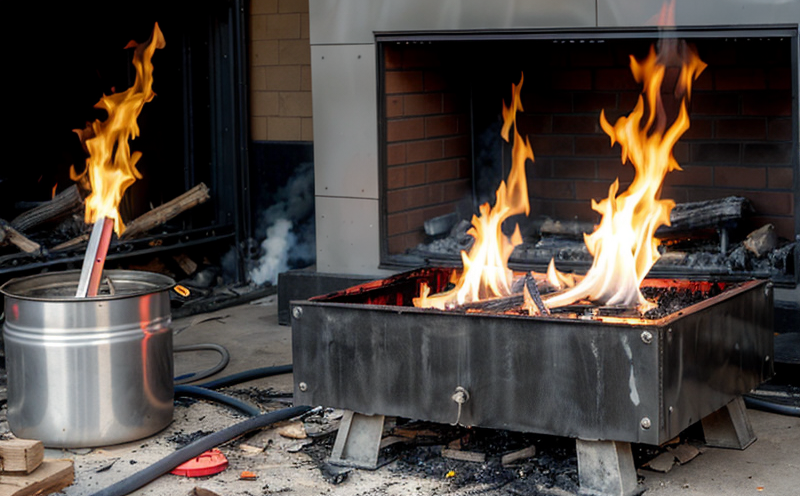UL 746A Polymeric Material Flammability Testing
The UL 746A standard is a stringent set of requirements designed to ensure that polymeric materials used in electrical and electronic devices are safe from ignition risks. This testing method evaluates the flammability characteristics of these materials, ensuring they meet the highest levels of safety for use in various environments.
UL 746A applies specifically to electrically operated equipment where the potential for a fire hazard may exist due to the presence of polymeric materials that can ignite or continue burning. This testing is critical in sectors such as consumer electronics, industrial machinery, and automotive components. By conducting UL 746A tests, manufacturers can verify that their products comply with industry standards and regulations, thereby protecting end-users from potential fire risks.
The test involves subjecting a small specimen of the polymeric material to controlled heating until it ignites. The apparatus used in this testing includes a specially designed furnace and sample holder. The specimen is subjected to an electrically generated heat source that mimics real-world conditions under which a fire may start. The duration, temperature, and other parameters are carefully controlled to ensure accurate results.
The UL 746A test provides quantitative data on the flammability of the material by measuring the time it takes for ignition to occur (ignition time) and the height of flaming combustion (burning length). These metrics help in assessing how quickly a fire might spread if the material were exposed to an ignition source. The testing also evaluates other parameters such as after-flame duration, which indicates the time taken by the specimen to extinguish itself once the flame is removed.
Preparation of the specimens before testing involves ensuring that they are representative of the materials used in the final product. This includes cutting the material into standard-sized samples and conditioning them at specific temperatures and humidities for a defined period, as per UL 746A specifications. The accuracy of these preparations is crucial to ensure reliable test results.
The testing process involves precise control over temperature, time, and other variables to simulate real-world scenarios accurately. This includes the use of calibrated instruments that monitor and record all relevant parameters during the test. The results are then analyzed to determine compliance with UL 746A standards. Compliance ensures that materials used in electrical devices meet safety requirements for fire prevention.
Understanding the significance of UL 746A testing is vital for quality managers, compliance officers, and R&D engineers involved in product development. By ensuring adherence to these standards, they can help prevent fires caused by flammable materials, thereby protecting both personnel and equipment. This testing also plays a crucial role in maintaining brand reputation and regulatory compliance.
The UL 746A test is widely recognized for its stringent criteria, which make it one of the most rigorous tests available for evaluating polymeric materials used in electrical devices. Its importance cannot be overstated as it directly impacts consumer safety and product reliability.
Industry Applications
- Consumer electronics (TVs, computers, smartphones)
- Industrial machinery (robots, conveyor belts)
- Automotive components (seat covers, dashboard materials)
- Appliances (microwaves, refrigerators)
The UL 746A test is essential for any industry where polymeric materials are used in electrical and electronic devices. By ensuring that these materials meet the stringent criteria set by UL 746A, manufacturers can reduce the risk of fires caused by flammable materials. This testing method helps to protect not only the products themselves but also the end-users who interact with them daily.
Eurolab Advantages
At Eurolab, we offer comprehensive UL 746A polymeric material flammability testing services tailored to meet your specific needs. Our team of experts ensures that every test is conducted using the latest equipment and techniques, ensuring accurate and reliable results.
- State-of-the-Art Facilities: We are equipped with advanced laboratories that adhere to international standards for conducting UL 746A tests.
- Experienced Technicians: Our team comprises highly skilled professionals who have extensive experience in this field, ensuring precision and accuracy in every test.
- Certified Instruments: We use calibrated instruments that are regularly maintained to ensure they meet the highest standards of accuracy.
- Comprehensive Reporting: Upon completion of each test, we provide detailed reports that include all relevant data, ensuring you have a clear understanding of your product's performance.
We understand the importance of compliance with industry standards and regulations. Our services are designed to help you meet these requirements while ensuring the highest level of safety for your products.
International Acceptance and Recognition
The UL 746A test is widely recognized across various international standards, including those from ISO, ASTM, EN, and IEC. This ensures that compliance with this standard is accepted globally, which can be crucial for manufacturers operating in multiple countries.
- ISO: While not directly referenced by UL 746A, the principles align closely with ISO standards on material safety.
- ASTM: ASTM D2863 is a test method that covers similar parameters for plastic materials as UL 746A does. However, UL 746A is more stringent in its criteria and acceptance levels.
- EN: European Norms such as EN 50261, which cover fire safety in electrical equipment, also align with the principles of UL 746A.
- IEC: The International Electrotechnical Commission's standards for electrical products often incorporate elements from UL 746A to ensure global compatibility and safety.
The universal acceptance of UL 746A testing in these international frameworks underscores its importance in ensuring the safe use of polymeric materials in electronic devices. By adhering to this standard, manufacturers can gain a competitive edge by demonstrating their commitment to product safety and quality.





